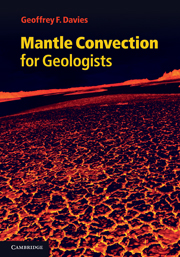Book contents
- Frontmatter
- Contents
- 1 Introduction
- 2 Context
- 3 Why moving plates?
- 4 Solid, yielding mantle
- 5 Convection
- 6 The plate mode of convection
- 7 The plume mode of convection
- 8 Perspective
- 9 Evolution and tectonics
- 10 Mantle chemical evolution
- 11 Assimilating mantle convection into geology
- Appendix A Exponential growth and decay
- Appendix B Thermal evolution details
- Appendix C Chemical evolution details
- References
- Index
3 - Why moving plates?
Published online by Cambridge University Press: 03 May 2011
- Frontmatter
- Contents
- 1 Introduction
- 2 Context
- 3 Why moving plates?
- 4 Solid, yielding mantle
- 5 Convection
- 6 The plate mode of convection
- 7 The plume mode of convection
- 8 Perspective
- 9 Evolution and tectonics
- 10 Mantle chemical evolution
- 11 Assimilating mantle convection into geology
- Appendix A Exponential growth and decay
- Appendix B Thermal evolution details
- Appendix C Chemical evolution details
- References
- Index
Summary
How were plates conceived of? How do we know they move? How were mantle plumes conceived?
The main story of the idea of continental drift and its ultimate transformation into the theory of plate tectonics has been well told (e.g. [12, 13]), and will not be recounted in detail here. However, the particular observations that led to the conception of moving plates are perhaps not so well known, as evidenced by the lack of recognition of the person who first conceived of plates. Also, the evidence that persuaded large segments of the geophysical and broader geological community of the reality of moving plates is worth repeating, so we know we are dealing with a theory well based in observations, and not just accepted on the authority of textbooks already a few decades old. (I say ‘already’ because I came into the Earth sciences in 1968, just after the view of the geophysical community had been transformed, and before many geologists had been persuaded, so of course to me it doesn't seem long ago.)
The lead-up
Alfred Wegener conceived of continental drift around 1912 [14] on the basis of the rough match of continental outlines across the Atlantic Ocean, which he was not the first to notice. He supported the concept with geological and palaeontological evidence. He refuted with sound physics the rival theory of land bridges that had risen and sunk, notably that there should be large and observable gravity anomalies associated with such changes.
- Type
- Chapter
- Information
- Mantle Convection for Geologists , pp. 13 - 25Publisher: Cambridge University PressPrint publication year: 2011



